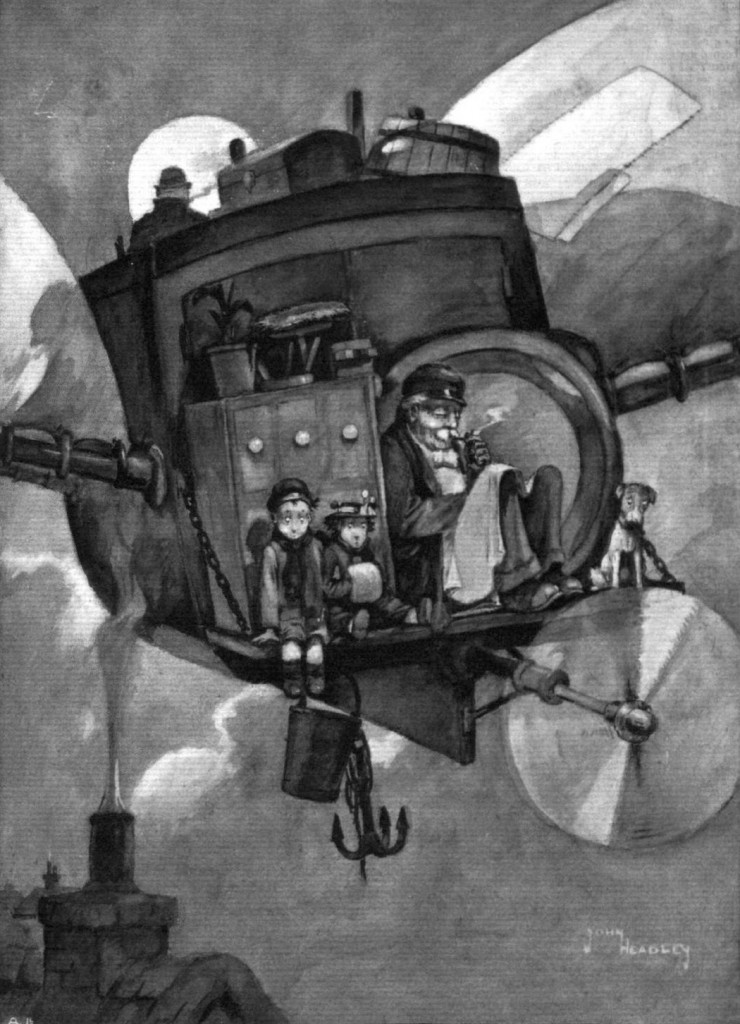This cartoon appeared in Flight in 1913.1 It’s entitled ‘In 1950’ with the caption ‘Flitting — by the light of the Easter moon’.
Now, ‘flitting’ is a term used in Scotland and the north of England to mean moving house. It is, or at least was, a practice which happened much more often there than in the south. In fact, it was something of an annual tradition in Scotland, with 25 May in particular being Flitting Day. The Motherwell Times described the scene in an 1898 leading article:
The week that has about gone provides at least one field day in the year for a considerable proportion of our population. Some people must flit every year, and they are no sooner installed in their new diggings than they begin to cast their vision about in order to select the battle-ground of their next upheaval. Now may be seen the central figure of the show, the commander-in-chief of the whole operations, with whitewash in her hair, fire in her eye, and anathemas on her lips, careering wildly about, seeking for some devoted one which to explode her righteous indignation. The poor titular head of the house is altogether a secondary and quite unimportant individual, and if ever he has been prone to at any time think of himself as somebody in particular, it is about now that he gets the starch taken out, and he is made to realize that he is only small potatoes after all.2
There’s an obvious gender aspect to this, and a less obvious class one too — the poor were much more likely to rent their homes rather than own them, and so were much more likely to move about. This is evident in Flight‘s cartoon, too: although the flitting in 1950 is being done with the aid of a (not particularly realistic) aeroplane, it has patches on its wings and the passengers perched on the back are of humble appearance. What’s more, it’s not just any old flitting that is being done, but moonlight flitting: i.e. secretly moving house in the dead of night, in order to escape creditors and landlords.
What is the point of this cartoon? It doesn’t seem to be any sort of topical reference, and it was published a couple of months before Flitting Day. Obviously it’s not meant to be taken particularly seriously. There’s probably a play on the other meaning of ‘flitting’, in the sense of the swift motion of small animals, particularly flying ones like birds and bats. But there is also a glance at Britain’s airminded future, even if in a very lighthearted way, at the idea that aviation would become an integral part of British society, that Britons would naturally and instinctively turn to the skies, that even the poor would have access to aircraft. It’s also perhaps a little satirical though, because — at least in this respect — becoming airminded has not fundamentally altered British society. People are still poor, still evade their debts, and still flit by moonlight; all the coming of flight has done is to change their mode of transportation.
![]() This work is licensed under a Creative Commons Attribution-NonCommercial-NoDerivatives 4.0 International License.
Permissions beyond the scope of this license may be available at http://airminded.org/copyright/.
This work is licensed under a Creative Commons Attribution-NonCommercial-NoDerivatives 4.0 International License.
Permissions beyond the scope of this license may be available at http://airminded.org/copyright/.


